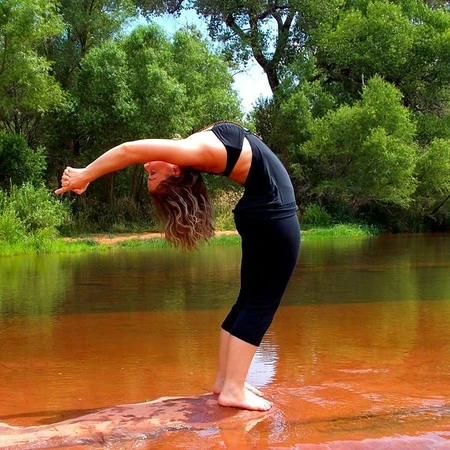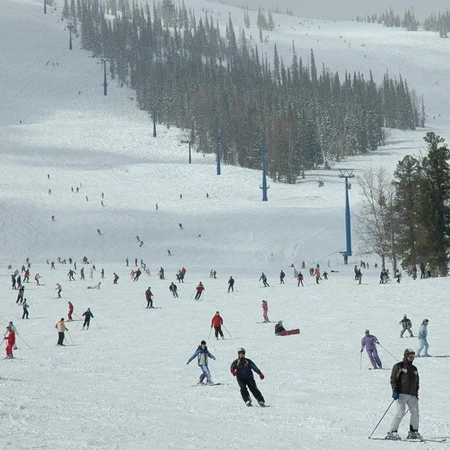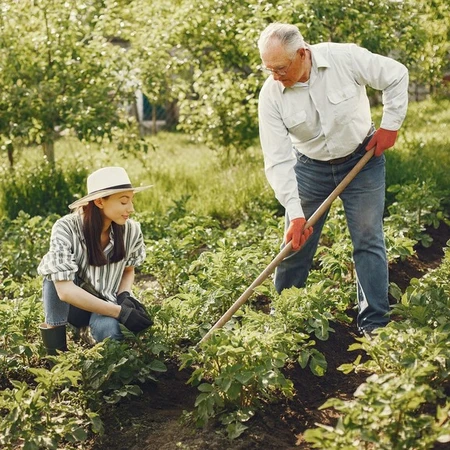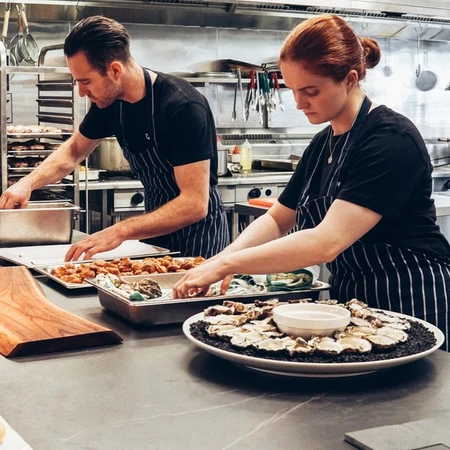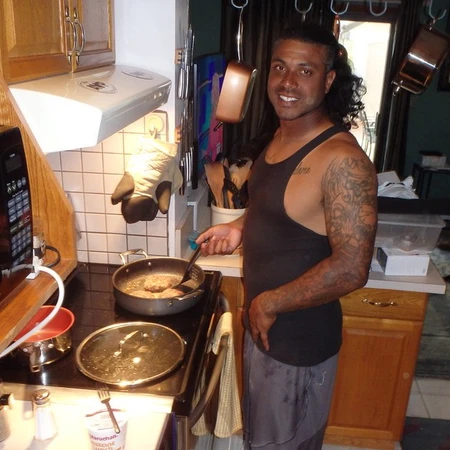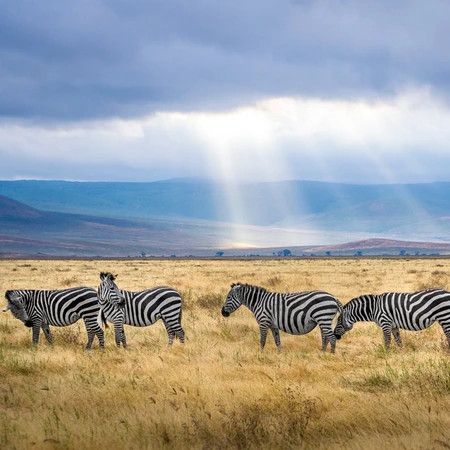FCE Speaking is the last part of your Cambridge English: First (B2) exam. It has 4 parts and is about 14 minutes long. There is usually one other test-taker like you, as some of the tasks involve interaction between candidates. It is not uncommon to have two test-takers. There will be two examiners present: one asking the questions (the interlocutor) and the other marking the answers (the assessor).
Below you will see an overview of the exam structure, sample questions and answers, tips on how to get a better score, and how your answer is assessed. You can use the menu below to navigate between parts or just read the whole thing (highly recommended if you are new to the exam).
1. Part 1: Interlocutor and candidate conversation (2 minutes)
— 1.1 Part 1 sample questions with answers
2. Part 2: Describing photos. Long and short turns (3 minutes)
— 2.1 Part 2 sample photos with answers
— 2.2 Part 2 tips and useful phrases
3. Part 3: Discussion between candidates and reaching an agreement (discussing a mind map) (3 minutes)
— 3.1 Part 3 sample mind map with answers
4. Part 4: Discussing and developing the topic from Part 3 (4 minutes)
— 4.1 Part 4 sample questions with answers
5. FCE Speaking marking criteria
Part 1: Interview (interlocutor and candidate)
Part 1 of FCE Speaking focuses on your ability to talk about topics of general interest, such as your work or studies, how you spend your free time, or your plans for the future — something you are familiar with. In this part, the interlocutor asks each candidate two or three questions. You are expected to listen to what the other candidate says as well as the questions asked. The reason is that you might be asked the same question (e.g., “And what about you?”). However, this part does not involve direct communication between candidates. FCE Speaking Part 1 is about two minutes long.
Keep your answers fairly short — two or three sentences should be enough. Stick to the topic you get in your question. Your answers should sound natural — do not use any memorised responses. Such answers are easy to spot and can often lead to a lower mark. Rehearsed answers might also not be about the question asked, as there is considerable variety in questions, even though the range of topics is quite limited.
For better or worse, there are no helpful phrases or tricks for FCE Speaking Part 1, as this part tests your general ability to talk about familiar topics. You might want to see it as a warm-up before the more challenging parts of FCE Speaking.
Part 1 sample questions and answers
What is your hometown like?
My hometown is Viña del Mar, it’s in Chile, just north of Santiago. It’s a coastal town that is popular with tourists because of the beautiful gardens and the beaches.
What do you do in your free time?
Well, I can’t say I have any particular hobbies to talk about; I guess I’m into oil painting. I enjoy painting landscapes in my free time because our city has such pretty views, they really inspire me!
How do you celebrate special occasions?
I’m not too outgoing, so I either go for a walk in the city and treat myself to some food or just stay at home and listen to the music. If it’s something big, I might invite a couple of friends over, but that’s kind of a rare thing to do for me.
Do you have any plans for this summer?
Oh, definitely! The plan is to go to an art school in California, provided that I have successfully passed this exam. Another option is to study art in Santiago, that would be okay for me as well.
Part 1 Summary
- Part 1 lasts for about 2 minutes for each candidate.
- There is a test-taker and examiner interaction; there is no interaction between test-takers.
- You get questions about familiar, everyday topics.
- There are usually two to four questions, and your answers should be fairly short (two or three shorter sentences).
Part 2: Describing photos (two test-takers)
This part tests your ability to describe pictures, to talk about similarities and differences between the pictures, and to speculate (to guess) about things related to the pictures. In this part of FCE Speaking there are usually two test-takers — Candidate A and Candidate B (however, sometimes you might get into a group with two other candidates). Candidate A goes first; they get two pictures from the interlocutor and a question they have to answer. The question is written on the page with the two pictures. The question can be about how people in the pictures might be feeling, what could be the advantages and disadvantages of the situation in each picture, and so on. See more FCE Speaking Part 2 examples with answers. After that, Candidate A gets one minute to answer the question.
After this, it’s time for Candidate B to answer one additional question from the interlocutor. This question relates to the same set of pictures. It can be either about choosing one of the pictures, like “In which might the people feel more comfortable?” or a more general one relating to the situation, where you don’t have to choose a picture, for example, “Is it better to study alone or with others?”. Candidate B has 30 seconds to answer the question.
After Candidate B has answered, they switch roles. This time, Candidate B gets two pictures, a question from the examiner, and one minute to answer it. Then Candidate A gets 30 seconds and one related question.
One important thing is that answering the question is only part of this task. You also have to describe both pictures and compare them. Continue reading for a more detailed explanation of each aspect.
Part 2 tips and useful phrases
In FCE Speaking Part 2, you have to achieve three things:
1 – compare (what is similar and what is different in the photos)
2 – describe (give a brief description of in in the photos)
3 – answer the question
1. Comparison vocabulary
Comparing is essential in Part 2 of FCE Speaking. You have to mention at least one thing that is common between the two photos and one that is similar. One of each should be enough, as you only have 1 minute for your answer. This is not a set-in-stone rule; adjust according to your pace of speech and confidence.
| Talking about similarities | Talking about differences |
|---|---|
| In both pictures, there is… Both pictures display/show… Pictures one and two have… Pictures one and two are similar in the way that there is/are… in each one. Just like in the left picture , the right one has… These two pictures have several things in common, such as/like… | Unlike the left picture, the one on the right has/shows/displays In contrast with the right picture, the image on the left is … Picture one…, while picture two… Picture two has a different idea of … if we compare it to the first photo While the second picture takes place in … Contrastingly, these pictures show different takes on *some topic* |
2. Description vocabulary
The first thing to remember is to switch between various phrases that introduce picture descriptions. Don’t reuse the same expression; alternate between them, for example:
In the first photo, we can see/there is/ … is shown.
The second picture shows/displays/demonstrates …
Another big mistake that test-takers make is that they use the wrong tense. The only tense you should be using to describe pictures is Present Continuous! Failing this leads to a lower mark – see the official assessment report, page 3.
Another common mistake is spending too much time on description. I’ve had students who would spend the entire minute talking about what’s in the picture. Remember, do not spend more than 15-20 seconds on that. Another helpful technique is to include comparisons in your description.
Finally, it is “in the picture”, not “on the picture” – you wouldn’t believe how often test-takers make this mistake!
“The first picture shows us a group of friends enjoying themselves. Contrastingly, in the second picture, we see colleagues who are having a business lunch.”
The part in bold text shows comparison; the underlined text is the usage of Present Continuous.
3. Answering the question.
When answering FCE Speaking Part 2 question, ideally you would want to do so for both pictures at the same time. You should answer it as you compare the photos, because otherwise you might not have enough time for comparison. Have a look at the model answers below to get a better idea of how to include comparison in your answer.
Part 2 sample questions and answers
Examiner: Candidate A, here are the photographs. They show people waiting for something. I’d like you to compare the photographs, and say in which picture the waiting feels longer.


Model answer
Candidate A: The left picture shows a man expecting his flight to arrive at the airport. He is sitting on a bench with his feet resting on the bag. In the picture on the right, we see a couple of people waiting for their bus at a rather late hour. They are engaged in a conversation.
I guess that for the man at the airport gate, the wait feels much longer. Air travel is a thrilling, probably even scary experience for most of us. The anxiety he might be having could make the time go really slowly for him. Also, flights can get late, and generally, you have to wait for quite some time before your plane is ready for boarding.
Examiner: Candidate B, how can one pass the time while waiting?
Candidate B: Well, there are many tried-and-true ways. In the past, people would read books or magazines, this was the most popular way of killing some time. Nowadays, everyone stares at their phone screen, either texting or looking at funny videos online.
Examiner: Thank you. Candidate B, now it’s your turn. Here are the photographs, and they show people having a rest. Please compare the two photographs, and say which picture shows people enjoying their rest the most.
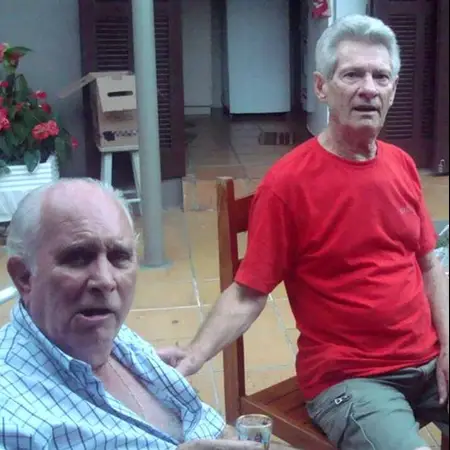

Candidate B: The left picture has two older men relaxing in what seems to be their own backyard. One of them is holding a drink, the other one is extending his arm to his friend. Both are dressed rather informally. In the other picture, we can see a young guy sitting on a stone fence, he is stylishly dressed. He appears to be looking at something.
I would say that the younger man in the second picture is enjoying his rest more. Maybe he has just finished his exams or achieved something meaningful. He looks like he is thinking about something, his mind wandering.
Examiner: Candidate A, how do you usually relax?
Candidate A: I don’t get much chance to relax nowadays, unfortunately. But when I do, I prefer having a walk in the park, either with my friends or alone. There is one in my neighbourhood, and it has plenty of trees as well as a small fountain. The sounds of running water help me clear my head and forget about the problems I have.
Keep in mind that you should use the present continuous when describing pictures (i.e., “This picture shows people hurrying to their work in the early morning hours”). More on tenses in English.
Another tricky bit is the preposition. You should use “in” when talking about something shown by the picture (i.e., “In this picture, we see a man strolling down the alley”). See this short note on prepositions for more examples.
More FCE Speaking Part 2 sample questions with answers
Part 2 Summary
- Part 2 is 1 minute, 30 seconds for each candidate.
- This part has test-taker and examiner interaction, using another test-taker’s pictures for the second part of the answer.
- You will be describing and comparing two pictures, as well as answering a question related to them.
- You have 60 seconds to talk about your pictures (long turn), 30 seconds to answer additional questions related to the topic of other test-taker’s pictures (short turn).
Part 3: Mind map discussion between two candidates (two test-takers)
In Part 3, candidates receive a mind map that contains a question and five prompts (also called aspects) to be discussed. They have 15 seconds to study it and then have to decide who starts the discussion.
The candidates’ task is to discuss the topic using the given prompts. FCE Speaking Part 3 consists of two smaller parts. In the first part, you should provide relevant responses on the topic, listen to and comment on the other candidate’s answers, and transition from one idea to another in a logical way. This part lasts for about two minutes.
In the second part of this task, you get an additional question and have to choose one of the prompts, with the answer providing reasoning, and either agree or disagree with the chosen prompt. You get around one minute for this part.
The focus of FCE Speaking Part 3 is to see candidates’ skills in interacting with each other. Some exam takers can find this particularly challenging.
Part 3 tips and useful phrases
There are three important aspects of FCE Speaking Part 3:
1 – Initiating the dialogue
2 – Going from one idea to another
3 – Coming to an agreement
1. Initiating the dialogue
At the beginning of FCE Speaking Part 3, one of you has to start the conversation. The key here is to be polite and allow your partner to choose, especially if they are shy or silent. You can either begin the conversation yourself or wait for your partner to go first.
| Starting the dialogue | Responding |
|---|---|
| Do you mind if I go first? Would you mind going first/starting? Care to go first? Should I begin, or would you like to go first? Would it be okay with you if I started this/went first? Is it okay for you if I start? | Yeah, sure, go ahead. Okay, I will! I’d rather you go first, if that’s okay with you. By all means, go ahead. Sure, not a problem. Please, be my guest! (this one is to encourage your partner to do what they suggest) |
A common rule is to let whoever goes first begin the conversation. Another thing that makes sense is to allow the other person initiate the dialogue in the second part.
2. Going from one idea to another
One thing that lowers your score in FCE Speaking Part 3 is simply waiting for your turn to speak, not paying much attention to whatever the other student has to say. Such behaviour is penalised – in fact, it is assessed in one of the marking criteria! A good approach is to incorporate some points from your partner’s answer into your own. Another important thing is the natural transition from one idea (prompt) to another, as your talk should be organic rather than a collection of isolated sentences and opinions. Below are some ways to make your ideas more connected.
3. Coming to an agreement
In the second half of Part 3, your task is to choose one of the aspects (prompts) in connection with the given question and either agree or disagree about whether it fits best. Agreeing is not mandatory. You are free to disagree, but do so with respect for each other, supporting your opinion with arguments. Here are some useful phrases for suggesting, encouraging a conversation, agreeing and disagreeing:
| Agreeing | Disagreeing (politely) |
|---|---|
| I totally agree with your point… I’m with you on that one… Your arguments are very compelling. I had a different idea, but your arguments sound very convincing. Your points are very persuasive, and I side with you on that one. | I see what you mean, however… You make some valid points, but let’s consider… With all due respect, I can’t agree/I have to disagree. Your logic here is flawless, but another point to consider is… I’m afraid I can’t agree with you on this point because… |
Suggesting ideas
I hold that … is probably one of the things we should take/consider/mention, since…
I think/believe that … is worth nominating/considering/mentioning/pointing out
Let’s not forget about …
Additionally, … should probably be included
Inviting to join
Where do you stand on…?
What’s your take on…?
Please share your thoughts on this matter?
What about your idea on …?
That’s what I think, but what about you?
Part 3 sample task and a model answer
Here are some different types of occupations people might choose to have. First, you have some time to look at the task. (15 seconds)
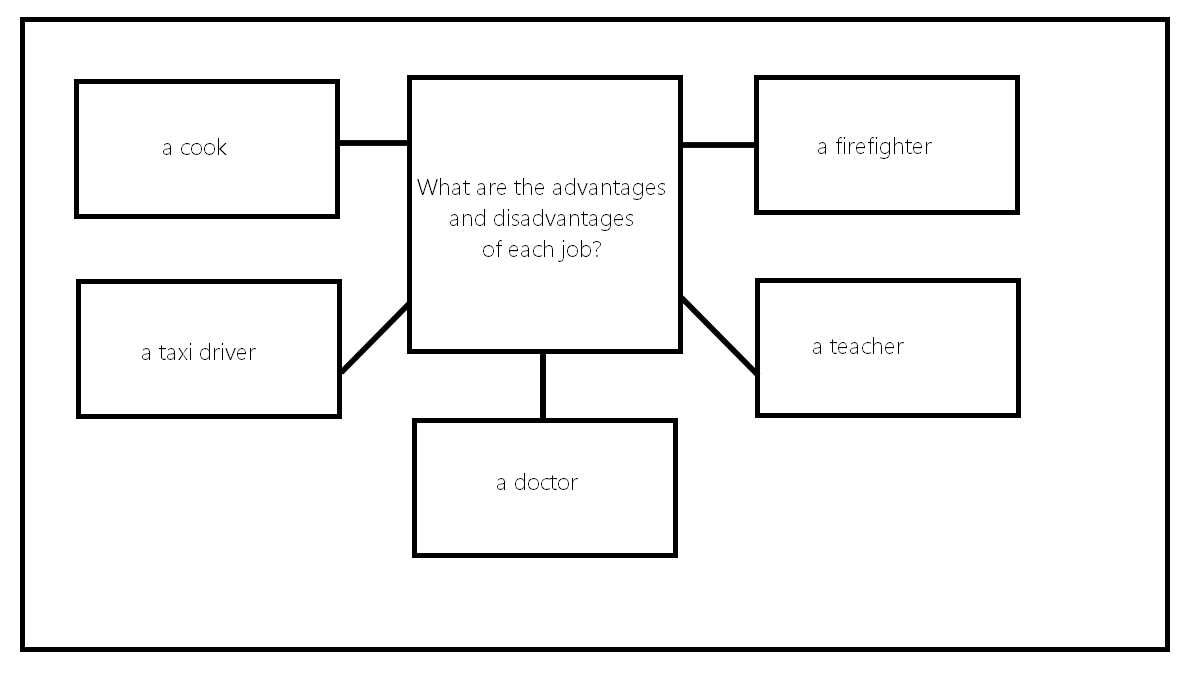
Now, talk to each other about the advantages and disadvantages of each of these occupations.
Model answer
Candidate A (Juan): Should I go first?
Candidate B (Marian): Yes, please do.
Juan: I think that working as a chef at a restaurant or some other place is great. It is a creative occupation, and you can express yourself through the dishes you make.
Marian: I get your points about expressing yourself, and I’m totally with you on that one. However, I guess with time it can get a bit repetitive – cooking day in, day out. Now, working as a doctor is never the same, wouldn’t you agree?
Juan: Yeah, I guess so. You face new challenges every day, it is a lot of responsibility, and the salary must be really high. You have to know a lot, though. What about being a teacher? You have to be pretty knowledgeable too, right?
Marian: Yes, definitely. I don’t think teachers make as much money as doctors do, but the job itself might be even more rewarding!
(The second half, coming to an agreement)
Examiner: Thank you. Now you have about a minute to decide which profession would be more suitable for a younger person.
Marian: Oh, maybe a driver? You need a lot of energy to stay behind the wheel all day, and young people tend to be much more energetic than older ones. What would you say?
Juan: I was thinking about teaching as the best choice for young people, but I guess you have to have more experience to be good at this. So yeah, I’d go with your option of a taxi driver!
Part 3 Summary
- Part 3 is about three minutes long
- You will have to interact with another test-taker (or two), each of you taking turns to express and justify your opinions
- There will be a discussion topic with five aspects in the form of a mind map in the first part
- An agreement between test-takers on one of the aspects has to be reached by the end of the second part
Part 4: Topic discussion (two test-takers)
The last part of FCE Speaking is a bit similar to Part 1 — you are asked questions related to the topic from Part 3 that you have to answer. However, there are three major differences in comparison with Part 1 of FCE Speaking. First of all, the questions are going to be more abstract than those in Part 1, and you will have to talk about things in general, not about your own experience. Secondly, your answers should be longer and more detailed — at least two or three longer sentences. Finally, the examiner will at some point encourage you and your partner to discuss one or two of the questions, so pay attention to your partner’s answers and be ready for a dialogue with them. This part of the exam can be up to four minutes long.
Part 4 sample questions with answers
Model answer
Examiner: Juan, what is more important when choosing a job — how enjoyable it is or the salary?
Juan: I’d say that it really depends on your age and your life situation. Sometimes we might really need the money, while others can afford to work for fun and experience social connections. I guess that ideally, you need to find a good balance between these things. Yeah, I’d say the right balance is most important.
Examiner: Thank you. Marian, what do you think?
Marian: Yes, I believe Juan is absolutely right. You don’t want to work just because you like it very much if you don’t get adequate financial compensation for your efforts. The opposite is true as well: working for money alone with no fun involved won’t get you far.
Model answer 2
Examiner: Marian, in your opinion, what kinds of jobs are going to be in demand in the future?
Marian: It’s really difficult to say – I mean, who knows what the future holds for us? I’d say that something to do with computers – after all, our society gets more and more dependent on computers and technology in general. Maybe it has something to do with robots. I’m not very good at predicting things!
Examiner: Juan, what’s your opinion?
Juan: Marian has made a very good point about computers. We rely on computers a lot, and I think eventually most professions will get replaced and automated in some way. With that in mind, we can say the IT industry will stay relevant and grow considerably in the coming years.
Candidate Discussion
Examiner: Now I’d like you two to talk about the following question: how can the government help people find employment?
Marian: Would it be ok with you if I went first?
Juan: Sure, go on.
Marian: For one, I would suggest including mandatory on-the-job training for high schoolers. This way, they would have an idea of what work actually is and make more educated decisions when choosing their career and major to study at college. Another way the state could help is to pay employers to take on people without experience – this would give the young more chances to land a job. What else do you think they could help with?
Juan: These are very nice suggestions. However, they are mostly aimed at younger job-seekers. To include older applicants, I think the government could create free trade courses so anyone could learn a set of skills like plumbing or basic electricity. This would allow them to get their foot in the door with more companies looking for specialists.
Marian: Yes, this does sound like a good idea! I wonder if something like this will ever be implemented, though…
Examiner: Thank you. That is the end of your FCE Speaking part.
Part 4 Summary
- Part 4 is about four minutes long.
- The interaction is between the examiner and two test-takers.
- You get more abstract questions and have to provide more abstract answers; your answers are expected to be longer than in Part 1 (three sentences and more).
- The examiner invites the test-takers to discuss the questions together.
FCE Speaking marking criteria
A good thing to keep in mind is the marking criteria for FCE. Knowing it helps you find weak spots in your language, like grammar, vocabulary, or the way you pronounce words.
There are two people on the exam responsible for marking. The person sitting in the back uses 5 Cambridge criteria that determine your proficiency in spoken English:
1. Grammar and vocabulary
2. Discourse management
3. Pronunciation
4. Interactive communication
5. Global achievement
The last one is assessed by the interlocutor (the one asking the questions and giving the cards). We shall look at all and explain the criteria below.
Each is scored individually, from 0 to 5 in 0.5 increments. They are then combined to get the average of the six (grammar, vocabulary, discourse management, pronunciation, interactive communication, and global achievement).
1. Grammar and vocabulary
What is assessed
Grammar – how appropriate, accurate, and varied your grammar is
- Usage of active and passive voice
- Verb patterns (infinitives, to-infinitives, gerunds)
- Usage of tenses to highlight a point, i.e. longer action when a short action takes place (Past Cont. + Past Simple)
- Ability to produce longer, multiple-clause sentences
- Conditional sentences
Vocabulary – range, flexibility, and accuracy of your words and phrases
- Collocations and prepositions
- Ability to rephrase in order to clarify a point, especially if your partner does not understand you
- No word repetition, good knowledge of synonyms and rephrasing
How to get a higher score
- Don’t just stick to one tense – learn and use many of them. For instance, use Present Continuous to talk about plans that somebody else knows about or Past Perfect + Past Simple to highlight how one thing in the past happened before the other.
- Conditional sentences are a great way to talk about the results (both real and imaginary) of actions or events that did or did not take place.
- Use both active and passive voices. Passive voice works great to show a more impersonal and objective view – great for FCE Speaking Part 3!
- Demonstrate your ability to rephrase. If you feel that you might not have expressed yourself in a clear way, introduce the idea in different words, starting with a phrase like ‘In other words’ or ‘Basically’.
Don’t feel bad about making mistakes; if you know you have made one, just correct yourself. Your ability to ‘fix’ a broken phrase is something they expect of you at Cambridge English: First exam.
2. Discourse Management
What is assessed
- Your ability to speak at length, connect your ideas and make your speech easy to follow and understand. A student’s use of discourse markers is expected to get them a high score.
- Vocabulary related to the topic discussed
- Aspects of language that make your speech easier to follow (i.e. personal pronouns, accurate usage of articles, and other means of making the idea more clear)
- Discourse markers (phrases like “What I mean is…”, “The thing is…”, “Well, that is a good point…” and others that people mostly use in spoken English)
- Cohesive devices (see below)
- No digressing (keeping the discussion on the same topic, not going too far away from it)
- Giving full answers (Express-explain-exemplify – state your idea, explain what you mean, and give some examples. That is, of course, not the only way to approach it, but it should give you the basic idea)
- Introducing new ideas (rather than going over the things you have already said)
- Repetition of words, phrases or ideas
How to get a higher score
- Know and use cohesive devices. They can be roughly grouped into ‘adding or elaborating’ (in addition, also, moreover, as well as), ‘showing consequence or result’ (as a result, consequently, so, thus, therefore) and ‘sequencing or ordering’ (firstly, first of all, to begin with, secondly, finally). These help structure your speech, making it both connected and easier to follow.
- Expand your vocabulary. It is pretty sad to see FCE candidates struggling to come up with any relevant words on topics as simple as Food, Holidays or Career. There is no way around it, learn new words! Here is a good vocabulary link that groups words and phrases in a nice way. It is from a different exam, but the topics are pretty much the same for FCE!
- Make sure to know the basics of articles in English. Use them to your advantage. Don’t forget about possessive pronouns and adjectives to make your speech more cohesive (it, this, that, one).
- If you feel that you need to mention some idea again, make sure to use synonyms or paraphrase it. Repetition of the same word, phrase or form can affect your score negatively, so show some variety to the examiner.
3. Pronunciation
What is assessed
First of all, elephant in the room – your accent is not going to be marked, nor will it affect your score. As long as your accent is easy to understand, you will do fine. This part checks other things, namely:
- Clear pronunciation: all the sounds that should be pronounced (more on that below)
- Stress placement, both in individual words and generally within the sentence (this is a common mistake with FCE test-takers)
- Correct usage of intonation to underline key points in your speech
How to get a higher score
- Make sure you know how words are pronounced – if you do, then you will sound much more confident. Some candidates are unsure about certain words and can pronounce them “under the breath” – not clearly. This can cause misunderstanding and get in the way of communication. Another quick tip is not to use shortened forms of words; for instance, say “I have done” instead of “I’ve done” to make sure the examiner and your partner understand you correctly.
- Pronunciation of sounds. A good example to illustrate is the words ‘thick’ and ‘sick’ – many non-native speakers have problems with the first one. Another problematic case is the difference in pronunciation between ‘v’ and ‘w’.
- Learn to use intonation. At this level, you should be able to use it to your advantage. More information is available in an article on this topic by the British Council.
- Do not underestimate the importance of sentence stress. It is a powerful tool to highlight the main point. For instance, consider these two sentences with the stressed word in capitals: “What do YOU think about this issue?” and “What do you think about THIS issue?”. In the first sentence, you focus on the opinion of your partner, while in the second one, you shift the focus to another issue or point.
4. Interactive communication
What is assessed
Your ability to engage in a conversation, support and develop it, connect ideas, and come to an agreement. This is what the examiners look at:
- How well can you start and maintain a dialogue by suggesting and discussing relevant points
- Ability to include your partner in the conversation as well as to encourage exchange of ideas
- Rephrasing or explaining your point if you see your partner struggling to understand you
- Sharing the time in the conversation equally and fairly, not “hogging” it (you shouldn’t dominate the conversation)
How to get a higher score
- Short answers do not give enough information to accurately assess your level of English. To give your examiners something to assess, you should come up with at least two long or three shorter sentences in Part 1 and about three to four longer sentences in Part 4.
- Be sure to include your partner! There are some phrases that you might find useful for that.
- More phrases to initiate the dialogue and support it with your ideas
- Do not take up too much time in FCE Speaking Part 3; remember that you only have two minutes in the first half and one minute in the second.
5. Global achievement
What is assessed
As the name suggests, this is a combination of all the previously mentioned criteria. The only difference is that the assessment is done by the person that asks the questions and handles the pictures. In short, this criteria checks the range of your grammar and vocabulary, how well you handle communication, and how easy it is to follow and understand you. We are not including any extra tips for this aspect; the ones above should be sufficient.
FCE Speaking Tips
- There is a number of typical Speaking mistakes. Know them to avoid embarrassment and guarantee a higher score.
- Do not attempt to answer other student’s questions even if you see them struggling; you might get penalized for that. However, you might help them by paraphrasing your ideas in the collaborative task.
- Keep practicing. The most effective way to improve your speaking is to use the language, ideally with a tutor. They can provide you with valuable feedback.
- Remember about eye contact with the person you are addressing. This is especially important in Part 3 when you interact with the other test taker.
- Make sure to use a range of tenses. Showing good command of Perfect and Continuous tenses will create much better impression. Sticking to simple tenses might get in the way of getting a higher mark.
- Be respectful to the other test-taker. Let them finish their thoughts, even if they struggle or take too much time to respond. Failing to do this will reflect negatively on your discourse management score.
- Maintain a steady pace and rhythm. This will allow you to avoid abrupt stops and give you enough time to think your idea through. Your ideal pace is determined by practice; you will understand the pace you are comfortable in.
Afterword
Probably the most important thing to keep in mind is that FCE is a B2 exam. Nobody expects perfection from you. Inaccuracies, hesitation and a somewhat limited grammatical and lexical range are not things you should worry too much about. Non-systematic mistakes (those that do not occur multiple times) will not affect your score dramatically. Deliver your responses in an easy-to-understand way, do not make any mistakes that get in the way of meaning, use proper stress and intonation. These should take you all the way to Grade A. Good luck!







